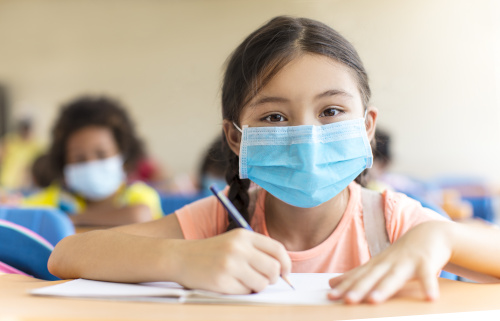The light at the end of the tunnel shines a little brighter every day, and it makes it easier to reflect on a handful of hard-won positives to emerge from the pandemic. These may not be universal truths, but some schools have unearthed opportunities from the past year’s challenges.
Increased engagement
When given the opportunity to connect through teacher conferences, traditionally, parents could take it or leave it. After all, barriers to creating connections loomed large. Virtual school led naturally to virtual conferences, and the rest is history. One district even saw 100 percent attendance at one elementary school’s conferences!
Community engagement has bloomed, too, as residents realized the critical role schools play for families. A renewed interest in local elections bodes well for school-related ballot initiatives and board elections. And while that can bring on conflict, opposing viewpoints, and loud feedback, this supercharged engagement is still engagement.
Focus on health and hygiene
An important component of whole child education, the physical health of students (and staff!) has been tossed into the spotlight in ways we’ve never seen before. Schools have prioritized handwashing and sanitizing surfaces for the past year. Influenza numbers have trended down, possibly thanks to this increase in hygiene and adoption of mask wearing to stop the spray of fluids when people sneeze or cough. In addition, students who present any symptoms of illness have been required to stay out of school, whereas before many students would attend classes while ill.
These changes have been helpful for students who have healthy immune systems. However, students who live with chronic illnesses may benefit from the increased virtual options, which ensure they feel included in school when not physically able to attend classes in person.
Designing learning spaces
School used to refer to a building. Now it’s the connection to education options with a wider array of settings.
In-building classrooms have undergone some pretty momentous changes during the 2020 school year. Classrooms have more space for students to spread out, different room dividers (clear, to ensure a nice line of sight), and individual rather than shared resources and manipulatives. It drives home the concept that flexible seating is not just for show: the ability to create different zones and spaces within a classroom has made a difference for teaching in person.
Out-of-building classrooms emerged this year, weather permitting, as options to increase air flow and space available for in-person learning. It’s another way to prevent the spread of disease, but so much more to kids who can integrate more movement and new enrichment into class.
Virtual classrooms may not be a first choice for every student, but for some they provide a welcome respite from challenges ranging from illness to transportation to social snafus. School leaders expect virtual options to stick around for at least the 2021-22 school year, and perhaps beyond.
Finally, the way school districts consider expanding building space has changed a bit out of necessity last year, but not in a detrimental way. Improving existing school buildings and converting existing real estate (think vacant big box stores) has served existing needs without waiting for new construction funds to be allocated by referenda. The environmental impacts of these decisions are worth noting too.
Quick pivots and design thinking
Let’s face it–decision making this past year has occurred at an unsustainable pace. But that pace has revealed lessons we can take forward into post-pandemic planning, too. District leaders have been making new decisions weekly (if not daily) for months, trying to pivot to the next step of reopening, hybrid, or mitigating staffing issues due to quarantine or lack of substitutes. Looking past the exhausting pace, this past year has shifted decision making into an extremely active and dynamic role. Not only did decisions have to be made quickly, but they also had to be made well.
This agile approach to problem solving can make a difference when used in healthier circumstances. Three steps to design thinking can help visionary leaders make transformative change.
Choice and cherishing school
Families had no shortage of decisions this past year, either. Many families will still face choices when students enter school this coming fall. In-person, online, or hybrid learning options add a lot of logistics to school districts, but going forward these options can be game-changers for families.
That’s probably why a survey of more than 375 school districts and charter schools showed 20 percent already plan to offer virtual school options after the pandemic ends. Even though remote learning was not the golden ticket for every family, some students thrive in an environment that places more emphasis on individual study and less on social structures.
As we reflect on the highs and lows of the past year, we see how much school matters to families. How much teachers’ hard work matters. How much the connections we build matter. If there’s just one good thing to come out of the pandemic, it’s that realization.
- 5 obstacles AI can help schools overcome - April 16, 2024
- Guidance counselors could help female high schoolers erase the STEM gender gap - April 16, 2024
- How video coaching inspires teacher self-reflection - April 15, 2024

